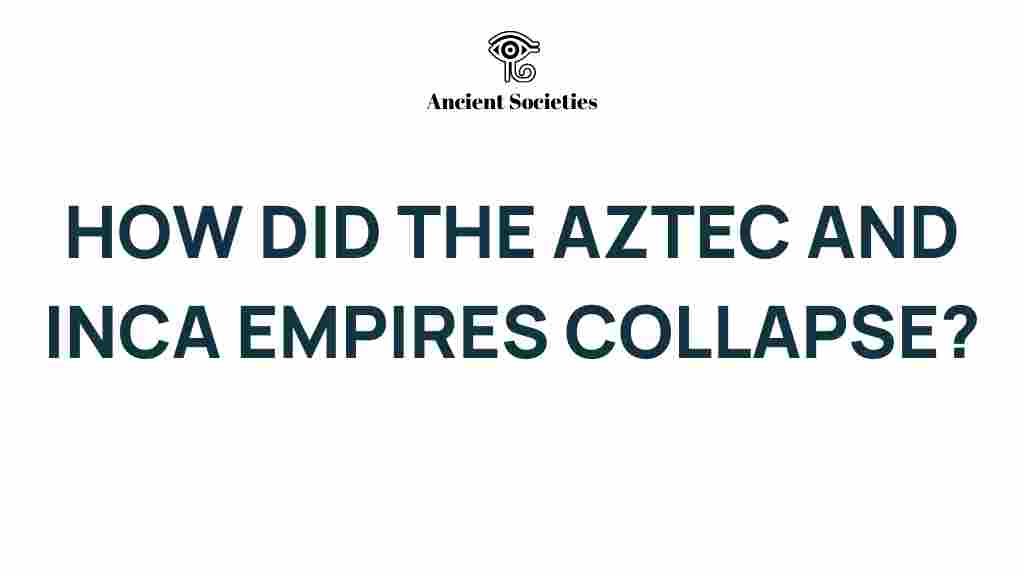The Downfall of Greatness: Unraveling the Collapse of the Aztec Empire and Inca Empire
The Aztec Empire and the Inca Empire represent two of the most sophisticated and powerful civilizations in pre-Columbian America. Their grandeur, cultural richness, and impressive achievements stand as a testament to human ingenuity. However, both empires faced catastrophic collapses primarily due to the Spanish conquest in the 16th century. This article delves into the history, culture, and the factors that led to the downfall of these great civilizations, shedding light on the broader implications for the indigenous peoples of the Americas.
Understanding the Aztec Empire
The Aztec Empire, centered in what is now Mexico City, was a formidable civilization that thrived from the 14th to the 16th centuries. This empire was renowned for its complex social structure, impressive architectural achievements, and rich cultural practices.
- Capital: Tenochtitlan, a marvel of engineering located on an island in Lake Texcoco.
- Society: Comprised of a hierarchy that included nobles, commoners, and slaves.
- Religion: Polytheistic beliefs that involved elaborate rituals, including human sacrifices, to appease their gods.
Understanding the Inca Empire
The Inca Empire, known for its vast territorial expanse along the Andes mountains, emerged around the early 15th century and reached its peak in the early 16th century. The Incas were remarkable builders and administrators, leaving behind an enduring legacy.
- Capital: Cusco, the administrative and cultural heart of the empire.
- Society: A highly organized society with a centralized government and a complex system of roads.
- Religion: Worship of the sun god Inti and a pantheon of deities, often involving agricultural ceremonies.
The Factors Leading to the Collapse of the Aztec and Inca Empires
The collapse of the Aztec Empire and the Inca Empire was not a sudden event but rather the result of a combination of internal weaknesses and external pressures, particularly from Spanish conquerors. Understanding these factors requires a closer look at the historical context and the dynamics at play during the 16th century.
1. Internal Conflicts and Political Instability
Both empires experienced significant internal strife that weakened their political structures:
- Aztec Empire: The Aztecs faced unrest from subjugated tribes who resented their rule. This discontent created opportunities for the Spanish to exploit divisions among the indigenous peoples.
- Inca Empire: The Inca Empire was embroiled in a civil war (the War of Succession) just before the arrival of the Spanish, which significantly weakened their defenses and unity.
2. The Impact of Disease
One of the most devastating factors leading to the collapse was the introduction of European diseases to which the indigenous peoples had no immunity:
- Smallpox: This disease decimated populations in both empires, significantly reducing their ability to resist conquest.
- Social Disruption: The loss of leaders and skilled laborers disrupted social structures and economies.
3. Spanish Military Technology and Strategy
The Spanish conquistadors employed advanced military technology and tactics that had a profound impact on the outcomes of their encounters with the Aztec and Inca forces:
- Firearms and Cannons: The Spanish had access to guns and cannons, which were far superior to the weaponry used by the indigenous armies.
- Alliances: The Spaniards formed strategic alliances with rival groups within the empires, further undermining the stability of both the Aztec and Inca states.
4. Cultural Underestimation
Both the Aztec and Inca civilizations had rich and complex cultures, but they often underestimated the resolve and strategy of the Spanish conquistadors:
- Misjudgment of Intent: The indigenous leaders often viewed the Spanish as mere traders or visitors rather than as conquerors.
- Religion and Superstition: Some Aztecs believed that the arrival of the Spanish was linked to their prophecies, leading to fatal underestimations of the threat they posed.
Step-by-Step Process of the Collapse
The collapse of the Aztec Empire and Inca Empire unfolded through a series of critical events:
1. Spanish Arrival
In 1519, Hernán Cortés arrived in the Aztec Empire, while Francisco Pizarro reached the Inca Empire in 1532. Their arrival marked the beginning of a new era of conflict.
2. Key Battles and Confrontations
Major confrontations such as the Siege of Tenochtitlan (1521) and the capture of Atahualpa (1532) were pivotal moments that led to the rapid decline of both empires.
3. Exploitation of Internal Divisions
The conquistadors leveraged existing rivalries among indigenous groups to gain support and weaken their opponents.
4. Establishment of Colonial Rule
Following the conquests, the Spanish established colonial rule, leading to the systematic dismantling of the cultural and social structures of the Aztec and Inca civilizations.
Troubleshooting: Lessons from the Collapse
Understanding the collapse of the Aztec and Inca Empires can provide valuable insights for contemporary societies:
- Value of Unity: Disunity can lead to vulnerability; maintaining solidarity is key in the face of external threats.
- Impact of Disease: The historical context of disease outbreaks underscores the importance of public health preparedness.
- Recognition of Diversity: Acknowledging and respecting diverse cultures can foster stronger societies.
For more insights on the impact of colonization, visit this resource.
Conclusion
The collapse of the Aztec Empire and the Inca Empire serves as a powerful reminder of the fragility of even the mightiest civilizations. Through understanding the historical context, internal dynamics, and the profound effects of the Spanish conquest, we can appreciate the complex tapestry of human history. The legacies of these civilizations continue to influence the cultural and social landscapes of modern-day Mexico and South America, reminding us of the rich heritage of the indigenous peoples and the resilience of their cultures.
For further reading on the legacies of the Aztec and Inca civilizations, check out this article.
This article is in the category History and created by AncientSocieties Team
